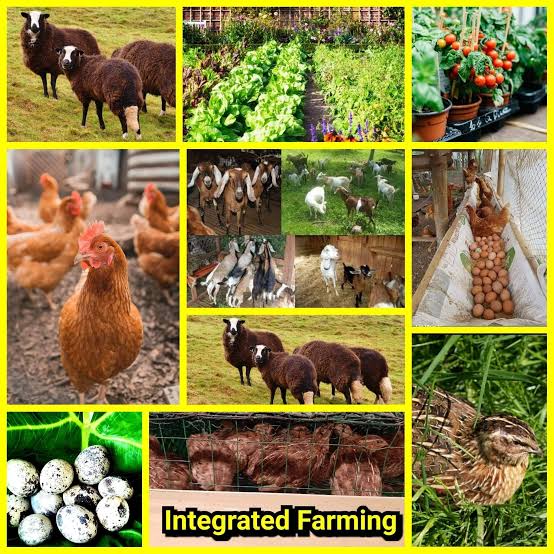
Integrated farming is an agricultural approach that involves combining crop production, fish farming, and livestock production, creating integrated biosystems. Waste from one part of the system becomes a crucial input in other components in the system. For instance, manure from sheep can be applied in plants to enhance soil fertility while maize stalks are used as fodder for sheep and cattle.
To create a stable and sustainable farm, integrated farming incorporates various components such as forestry, livestock keeping, horticulture, and agriculture. It integrates crop production into other activities such as biogas production, mushroom cultivation, poultry and fish farming, and cattle rearing. The integrated system aims at enhancing resource integration, minimizing management costs, increasing diversification and farm productivity, and enhancing market linkages.
What to Consider while Choosing the Enterprises for Integrated Farming System (IFS):
- Soil and climatic features of an area/ locality.
- Resource availability with the farmers.
- Present level of utilization of resources.
- Economics of proposed integrated farming system.
- Farmers managerial skill.
- Social customs prevailing in the locality.
How does Integrated farming work?
General crop production, livestock keeping, forestry, and fish farming are easy to integrate. Crops such as maize, sorghum, bananas, corn, and sugarcane perform well in most parts of the country. After harvesting, wastes, stalks, and leaves can either be composted to form manure or chopped into very small pieces and used as animal feeds for cattle, sheep, poultry, and fish.
Organic manures provided by chicken, sheep, cattle, and pigs can be used as organic fertilizer for the crops and aquatic plants near the fish pond or to feed plankton. Aquatic plants, plankton, and crop wastes from the farm are then used to feed the fish. Silt from fish ponds contains a wide range of nutrients and can act as an important fertilizer for the crops. In some cases, especially in drier areas, water from fishponds can be used for irrigation. Farmers can plant trees around their gardens which provide firewood and act as windbreakers, protecting crops against strong winds.
Integrated farming gathers diversified components such as agriculture, horticulture, forestry and animal husbandry, thus making a stable farm. It’s always emphasized to combine cropping with other activities, such as poultry, piggery, mushroom cultivation, biogas plant etc
How can farmers benefit integrated farming system
- Enhanced Productivity is one of the most important benefits of an integrated farming system. Increasing productivity means that economic yield increases per unit area per unit by time due to intensification of crops and allied farming enterprises.
- Profitability factor also increases as productivity increases. This is because we are using the waste material or by-product of one enterprise as an input into another farming enterprise.
- Adoption of New Technology is another important benefit of an integrated farming system. This is because adoption of technology needs money. Large farmers have finances so they can adopt it easily. However, small farmers usually face shortage in finances. But due to the integrated farming system, they have the opportunity to increase their returns from farming and adapt to new technology.
- Environmental Safety is ensured in this approach. As we are using the waste material of one enterprise as input into the production function of another type of enterprise, so waste pollution is minimized and hence environmental safety is ensured.
- Fight Against Deforestation can win by this approach. Planting timber and fuel wood along with the crops in the field not only utilizes the free space of land but also supplies wood for many purposes. Hence pressure on natural forests can be reduced and the natural ecosystem is preserved.
Some other benefits of this type of farming system are listed below;
- Promotion of Agro-Industry
- Increased Input Efficiency
- Cost Minimization for Input Use
- Increased Employment
- Fodder Security for Livestock
- Recycling
- Continuous Income Round the Year
- Energy Saving
Some limitation with Integrated Farming System
- Lack of knowledge about sustainable farming systems
- Unavailability of various farming system models
- Lack of credit facilities with low interest rates
- Lack of banking acumen and habit to fully utilize loan facilities
- Lack of marketing information among farmers
- Lack of deep freezing and storage facilities
- Dedicated/committed extension services
- Lack of timely availability of inputs
- Lack of knowledge/education within agricultural population, particularly among rural youth
Conclusion
IFS is a promising approach for increasing overall productivity and profitability through recycling the farm by-products, and efficient utilization of available resources. The combination of different enterprises needs to be seriously viewed. This can go a long way to uplift rural life through increased income. It could further generate employment opportunities to the farming communities round the year and provide a better economic and nutritional security.


You seem to be committed to assist farmers to grow.
Oxfarm has already done soil test for my Makindu farm
They are now doing my borehole water analysis so that we can start off on various fruits farming e.g Pixie Oranges, pawpaw, pomegranate and vegetables.
I wish you could join us to start together especially on the irrigation part.
Good